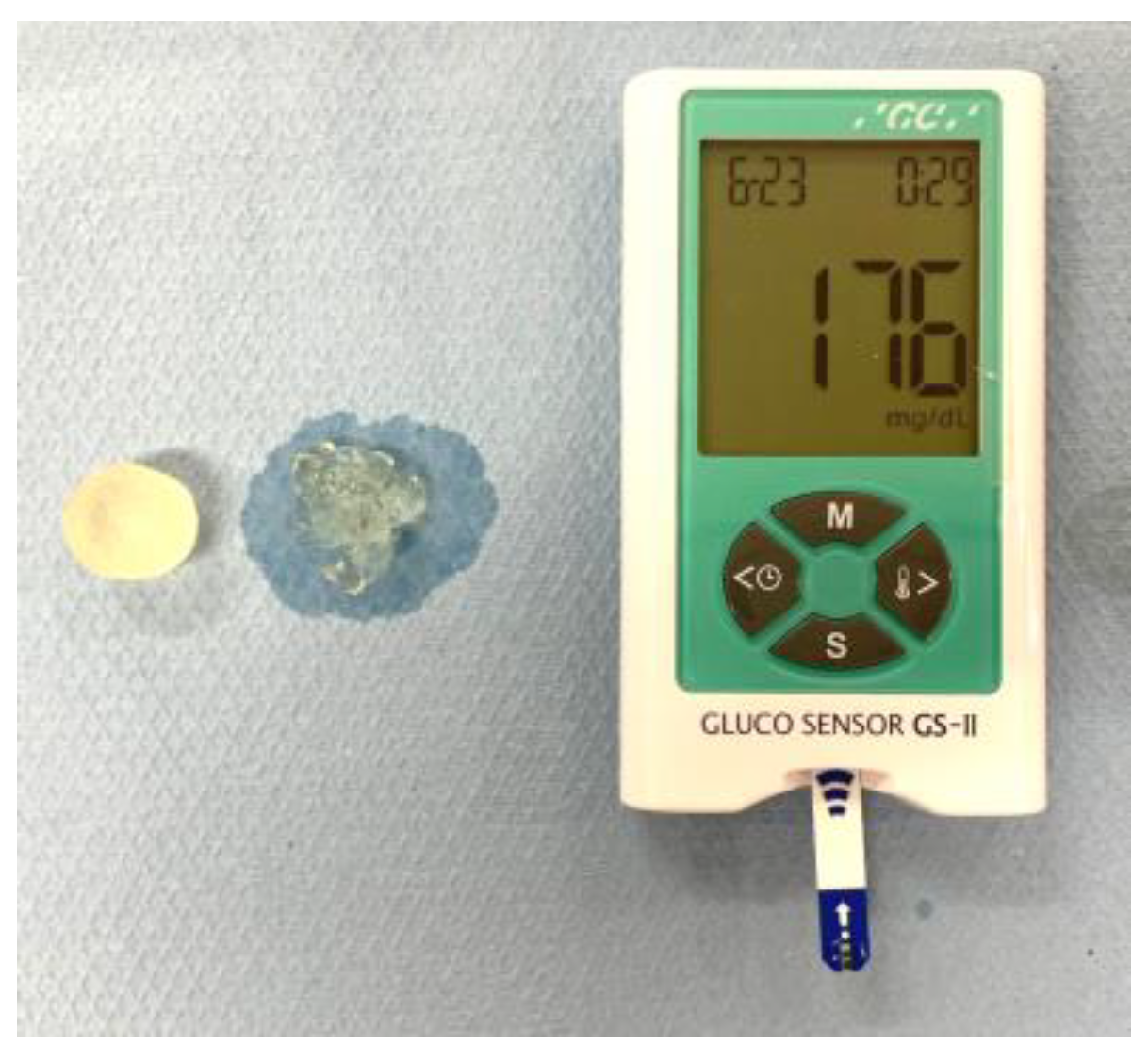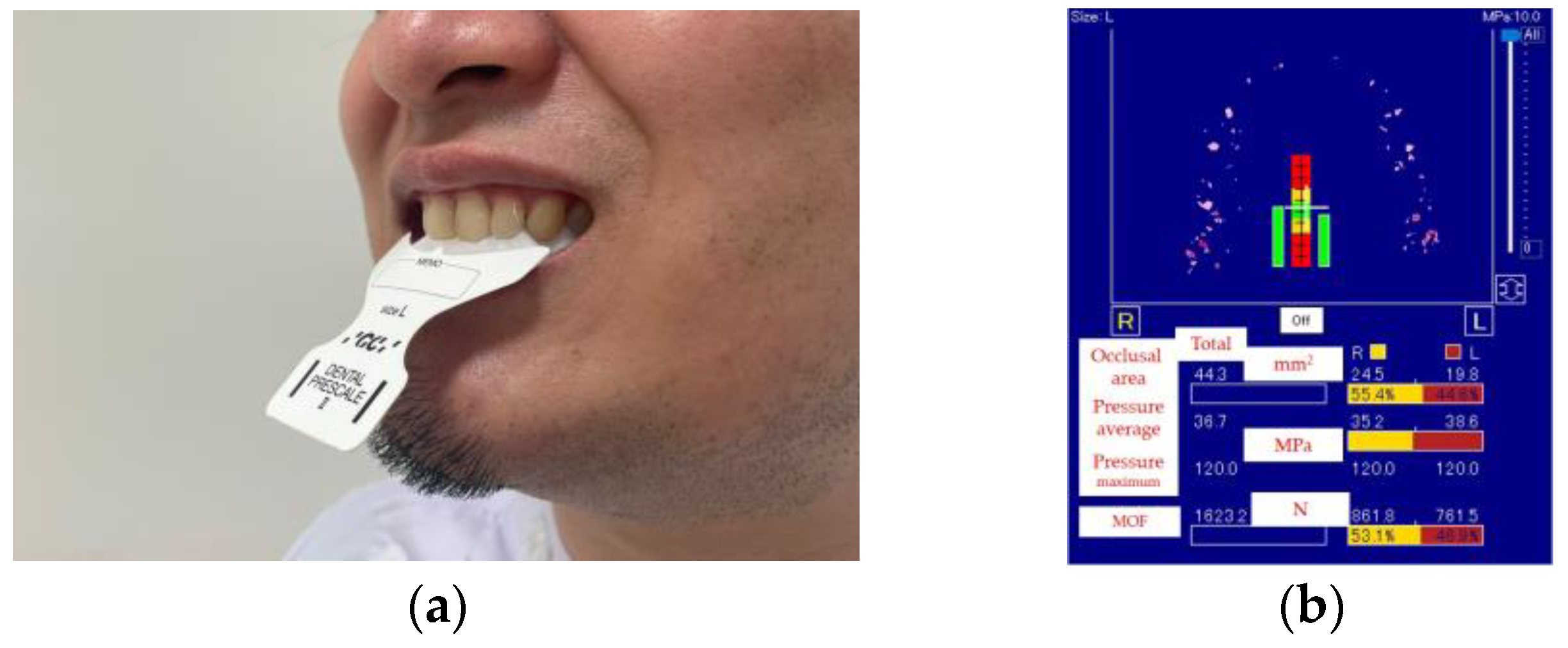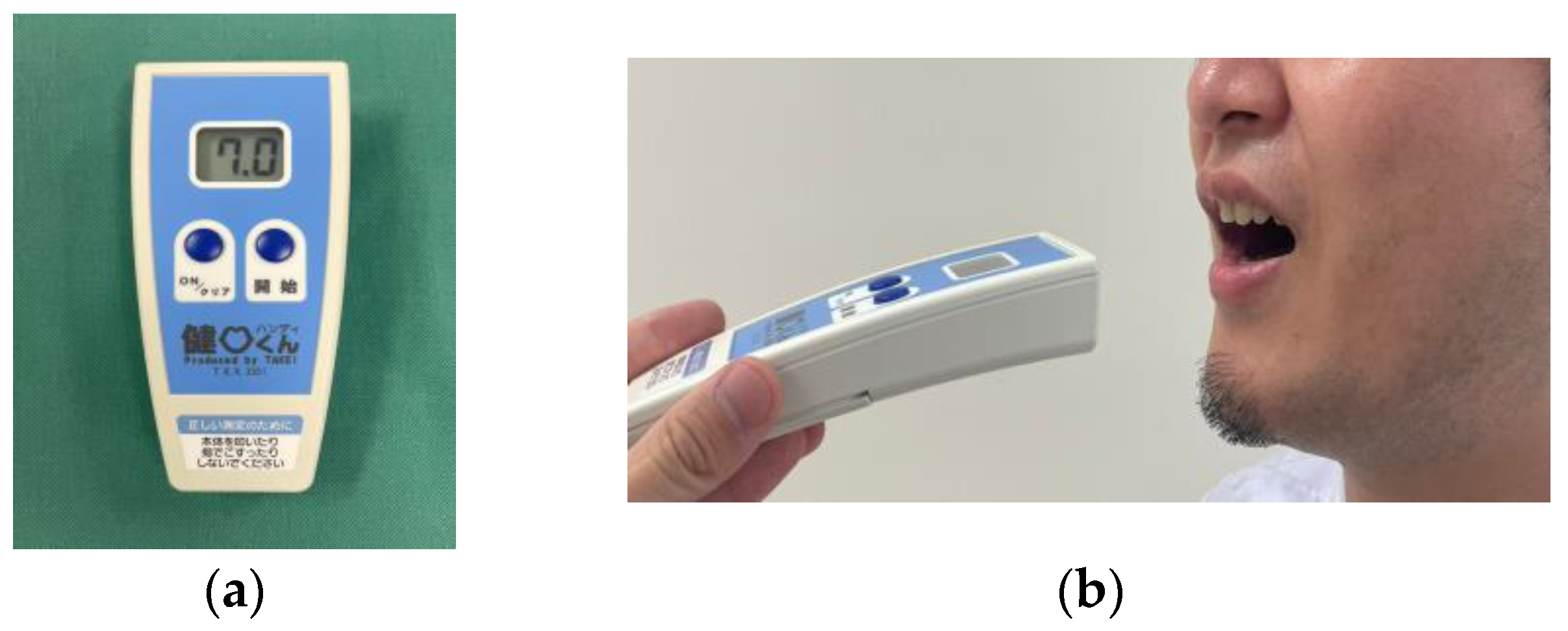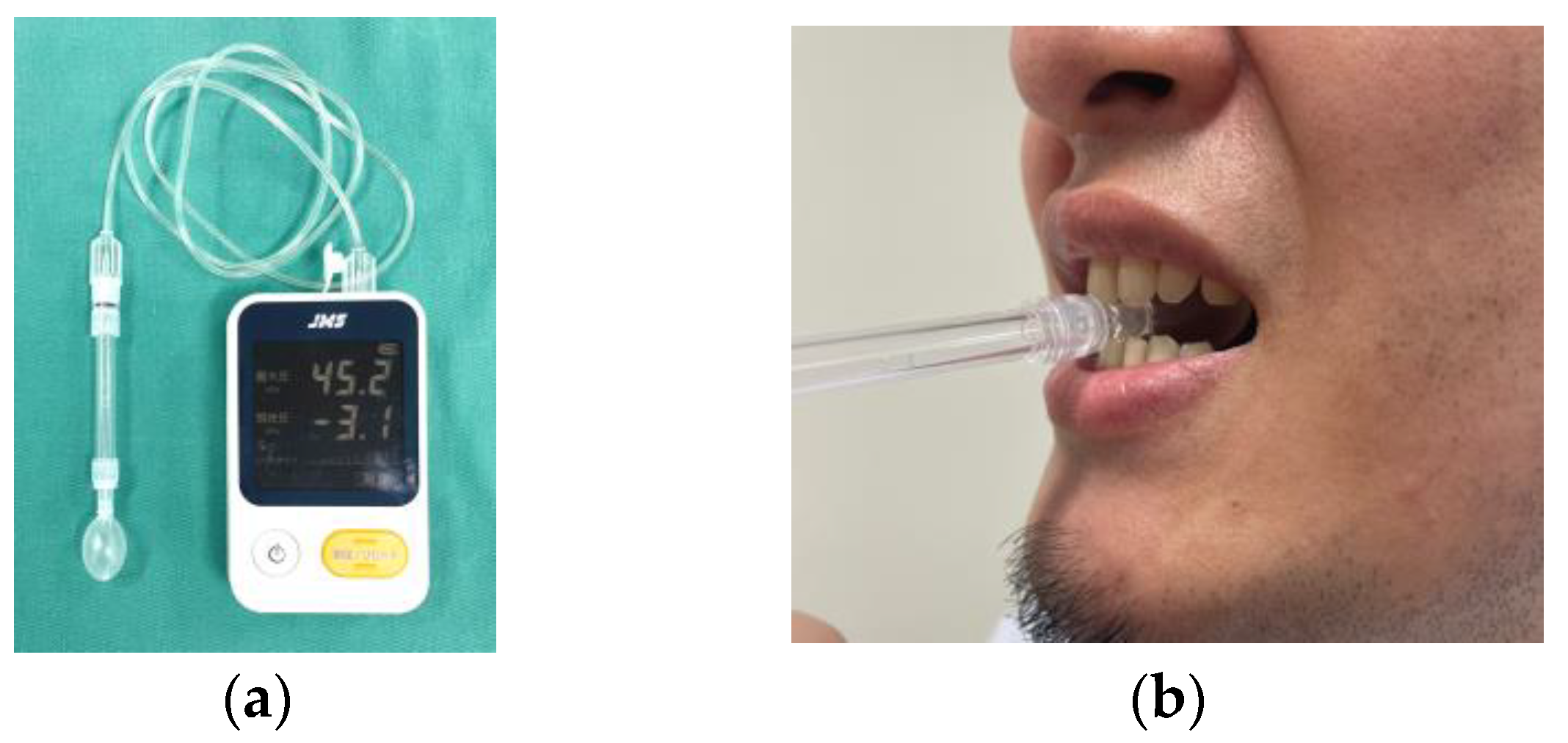Comprehensive Analyses of Masticatory Function in Maxillectomy Patients with Functioning Removable Prostheses: A Retrospective Cross-Sectional Study
Abstract
1. Introduction
2. Materials and Methods
2.1. Study Subjects
- Patients with maxillectomy due to benign or malignant tumors;
- Patients after prosthetic rehabilitations in surgically resected areas using removable prostheses without any implants and without any problems in their removable prostheses at the time of evaluation of their oral functions;
- Patients with the data of their oral functions that had been evaluated when they had used their removable prostheses in surgically resected areas without any problems.
- Patients with maxillectomy due to other diseases (except for tumors);
- Patients without prosthetic rehabilitations, with prosthetic rehabilitations in surgically resected areas using fixed prostheses or implant-assisted prostheses, or with difficulties in the usage of their removable prostheses in surgically resected areas;
- Patients without data on their oral functions.
2.2. Data Collection
2.2.1. Subjects’ Profiles
2.2.2. Oral Functions
- Masticatory function: masticatory function was defined by the glucose concentration in 10 mL water from the particles of crushed gummy jelly (2 g) after 20 s voluntary chewing. Commercially available devices (Glucoram (a gummy jelly) and Gluco Sensor GS-II, GC Co., Tokyo, Japan) were adopted as described previously [5,15], and images are shown in Figure 1. The threshold value was defined as 100 mg/dL [25,26].
- 2.
- Oral moisture (OM): OM was measured using an oral moisture checker (Mucus, Life Co., Ltd., Saitama, Japan) (Figure 2). Briefly, a tip of this device with a disposal cover was put on the tongue for a few seconds, and the measurement value was presented. The threshold value was defined as 27.0, and a lower value suggested oral dryness [25].
- 3.
- 4.
- Tongue–lip motor function; oral diadochokinesis (ODK): tongue–lip motor function was defined by ODK (Figure 4). The repetitive syllables /pa/, /ta/, and /ka/ for 5 s were counted using a commercially available device (Kenkokun Handy, Takei Scientific Instruments Co., Ltd., Niigata, Japan) to evaluate lip motor function, the anterior and posterior regions of tongue motor function, respectively. The threshold value was defined as 6 times per second [25,26].
- 5.
- Maximum tongue pressure (MTP): MTP was measured using a commercially available device (JMS tongue pressure measuring device TPM-01, JMS Co., Ltd., Hiroshima, Japan) (Figure 5). Briefly, the compression against an inflated balloon produced by tongue elevation was defined as MTP. The threshold value was defined as 30 kPa [25,26].
2.2.3. History of Their Tumor Therapy
2.3. Statistical Analyses
3. Results
3.1. Study Subjects and Numerical Data
3.2. Correlations between Masticatory Function and Other Numerical Data
3.3. Effects of Tumor Therapy-Related Factors on Masticatory Function
3.4. A Comprehensive Analysis of Masticatory Functions in Maxillectomy Patients
4. Discussion
5. Conclusions
Author Contributions
Funding
Institutional Review Board Statement
Informed Consent Statement
Data Availability Statement
Conflicts of Interest
References
- Umino, S.; Masuda, G.; Fujita, K. Masticatory performance with a prosthesis following maxillectomy: An analysis of 43 cases. J. Oral Rehabil. 2003, 30, 642–645. [Google Scholar] [CrossRef]
- Matsuyama, M.; Tsukiyama, Y.; Tomioka, M.; Koyano, K. Clinical assessment of chewing function of obturator prosthesis wearers by objective measurement of masticatory performance and maximum occlusal force. Int. J. Prosthodont. 2006, 19, 253–257. [Google Scholar]
- Shibuya, Y.; Ishida, S.; Kobayashi, M.; Hasegawa, T.; Nibu, K.; Komori, T. Evaluation of masticatory function after maxillectomy using a colour-changing chewing gum. J. Oral Rehabil. 2013, 40, 191–198. [Google Scholar] [CrossRef] [PubMed]
- Cao, Y.; Yu, C.; Liu, W.; Miao, C.; Han, B.; Yang, J.; Li, L.; Li, C. Obturators versus flaps after maxillary oncological ablation: A systematic review and best evidence synthesis. Oral Oncol. 2018, 82, 152–161. [Google Scholar] [CrossRef] [PubMed]
- Fujikawa, N.; Ogino, Y.; Koga, S.; Ueno, M.; Moroi, R.; Koyano, K. Validation of masticatory function and related factors in maxillectomy patients based on the concept of “oral hypofunction”: A retrospective cross-sectional study. J. Prosthodont. Res. 2021, 65, 449–454. [Google Scholar] [CrossRef] [PubMed]
- Said, M.M.; Otomaru, T.; Yeerken, Y.; Taniguchi, H. Masticatory function and oral health-related quality of life in patients after partial maxillectomies with closed or open defects. J. Prosthet. Dent. 2017, 118, 108–112. [Google Scholar] [CrossRef]
- Koga, S.; Ogino, Y.; Fujikawa, N.; Ueno, M.; Kotaki, Y.; Koyano, K. Oral health-related quality of life and oral hygiene condition in patients with maxillofacial defects: A retrospective analysis. J. Prosthodont. Res. 2020, 64, 397–400. [Google Scholar] [CrossRef]
- Petrides, G.A.; Dunn, M.; Charters, E.; Venchiarutti, R.; Cheng, K.; Froggatt, C.; Mukherjee, P.; Wallace, C.; Howes, D.; Leinkram, D.; et al. Health-related quality of life in maxillectomy patients undergoing dentoalveolar rehabilitation. Oral Oncol. 2022, 126, 105757. [Google Scholar] [CrossRef]
- Kosaka, T.; Ono, T.; Kida, M.; Kikui, M.; Yamamoto, M.; Yasui, S.; Nokubi, T.; Maeda, Y.; Kokubo, Y.; Watanabe, M.; et al. A multifactorial model of masticatory performance: The Suita study. J. Oral Rehabil. 2016, 43, 340–347. [Google Scholar] [CrossRef]
- Takagi, D.; Watanabe, Y.; Edahiro, A.; Ohara, Y.; Murakami, M.; Murakami, K.; Hironaka, S.; Taniguchi, Y.; Kitamura, A.; Shinkai, S.; et al. Factors affecting masticatory function of community-dwelling older people: Investigation of the differences in the relevant factors for subjective and objective assessment. Gerodontology 2017, 34, 357–364. [Google Scholar] [CrossRef]
- Morita, K.; Tsuka, H.; Kato, K.; Mori, T.; Nishimura, R.; Yoshida, M.; Tsuga, K. Factors related to masticatory performance in healthy elderly individuals. J. Prosthodont. Res. 2018, 62, 432–435. [Google Scholar] [CrossRef] [PubMed]
- Sagawa, K.; Furuya, H.; Ohara, Y.; Yoshida, M.; Hirano, H.; Iijima, K.; Kikutani, T. Tongue function is important for masticatory performance in the healthy elderly: A cross-sectional survey of community-dwelling elderly. J. Prosthodont. Res. 2019, 63, 31–34. [Google Scholar] [CrossRef] [PubMed]
- Kugimiya, Y.; Watanabe, Y.; Igarashi, K.; Hoshino, D.; Motokawa, K.; Edahiro, A.; Ueda, T.; Takano, T.; Sakurai, K.; Taniguchi, Y.; et al. Factors associated with masticatory performance in community-dwelling older adults: A cross-sectional study. J. Am. Dent. Assoc. 2020, 151, 118–126. [Google Scholar] [CrossRef] [PubMed]
- Maruyama, M.; Morita, K.; Kimura, H.; Nishio, F.; Yoshida, M.; Tsuga, K. Association between masticatory ability and oral functions. J. Clin. Exp. Dent. 2020, 12, e1011–e1014. [Google Scholar] [CrossRef]
- Kreeft, A.M.; Krap, M.; Wismeijer, D.; Speksnijder, C.M.; Smeele, L.E.; Bosch, S.D.; Muijen, M.S.; Balm, A.J. Oral function after maxillectomy and reconstruction with an obturator. Int. J. Oral Maxillofac. Surg. 2012, 41, 1387–1392. [Google Scholar] [CrossRef]
- de Groot, R.J.; Merkx, M.A.W.; Hamann, M.N.S.; Brand, H.S.; de Haan, A.F.J.; Rosenberg, A.J.W.P.; Speksnijder, C.M. Tongue function and its influence on masticatory performance in patients treated for oral cancer: A five-year prospective study. Support. Care Cancer 2020, 28, 1491–1501. [Google Scholar] [CrossRef]
- Koyama, S.; Sasaki, K.; Inai, T.; Watanabe, M. Effects of defect configuration, size, and remaining teeth on masticatory function in post-maxillectomy patients. J. Oral Rehabil. 2005, 32, 635–641. [Google Scholar] [CrossRef]
- Sreeraj, R.; Krishnan, V.V.M.; Thankappan, K. Comparison of Masticatory and Swallowing Functional Outcomes in Surgically and Prosthetically Rehabilitated Maxillectomy Patients. Int. J. Prosthodont. 2017, 30, 573–576. [Google Scholar] [CrossRef]
- de Groot, R.J.; Wetzels, J.W.; Merkx, M.A.W.; Rosenberg, A.J.W.P.; de Haan, A.F.J.; van der Bilt, A.; Abbink, J.H.; Speksnijder, C.M. Masticatory function and related factors after oral oncological treatment: A 5-year prospective study. Head Neck 2019, 41, 216–224. [Google Scholar] [CrossRef]
- Ohashi, Y.; Shiga, K.; Katagiri, K.; Saito, D.; Oikawa, S.I.; Tsuchida, K.; Ikeda, A.; Miyaguchi, J.; Kusaka, T.; Yamada, H. Evaluation and comparison of oral function after resection of cancer of the upper gingiva in patients who underwent reconstruction surgery versus those treated with a prosthesis. BMC Oral Health 2021, 15, 347. [Google Scholar] [CrossRef]
- Chigurupati, R.; Aloor, N.; Salas, R.; Schmidt, B.L. Quality of life after maxillectomy and prosthetic obturator rehabilitation. J. Oral Maxillofac. Surg. 2013, 71, 1471–1478. [Google Scholar] [CrossRef] [PubMed]
- Seignemartin, C.P.; Miranda, M.E.; Luz, J.G.; Teixeira, R.G. Understandability of Speech Predicts Quality of Life Among Maxillectomy Patients Restored With Obturator Prosthesis. J. Oral Maxillofac. Surg. 2015, 73, 2040–2048. [Google Scholar] [CrossRef] [PubMed]
- Chen, C.; Ren, W.H.; Huang, R.Z.; Gao, L.; Hu, Z.P.; Zhang, L.M.; Li, S.M.; Dong, K.; Qi, H.; Zhi, K.Q. Quality of Life in Patients After Maxillectomy and Placement of Prosthetic Obturator. Int. J. Prosthodont. 2016, 29, 363–368. [Google Scholar] [CrossRef] [PubMed]
- Breeze, J.; Rennie, A.; Morrison, A.; Dawson, D.; Tipper, J.; Rehman, K.; Grew, N.; Snee, D.; Pigadas, N. Health-related quality of life after maxillectomy: Obturator rehabilitation compared with flap reconstruction. Br. J. Oral Maxillofac. Surg. 2016, 54, 857–862. [Google Scholar] [CrossRef] [PubMed]
- Minakuchi, S.; Tsuga, K.; Ikebe, K.; Ueda, T.; Tamura, F.; Nagao, K.; Furuya, J.; Matsuo, K.; Yamamoto, K.; Kanazawa, M.; et al. Oral hypofunction in the older population: Position paper of the Japanese Society of Gerodontology in 2016. Gerodontology 2018, 35, 317–324. [Google Scholar] [CrossRef]
- Iwasaki, M.; Hirano, H. Decline in Oral Function and Its Management. Int. Dent. J. 2022, 72, S12–S20. [Google Scholar] [CrossRef]
- van der Bilt, A.; Engelen, L.; Pereira, L.J.; van der Glas, H.W.; Abbink, J.H. Oral physiology and mastication. Physiol. Behav. 2006, 89, 22–27. [Google Scholar] [CrossRef]
- Dos Santos, D.M.; de Caxias, F.P.; Bitencourt, S.B.; Turcio, K.H.; Pesqueira, A.A.; Goiato, M.C. Oral rehabilitation of patients after maxillectomy. A systematic review. Br. J. Oral Maxillofac. Surg. 2018, 56, 256–266. [Google Scholar] [CrossRef]
- Ono, T.; Kohda, H.; Hori, K.; Nokubi, T. Masticatory performance in postmaxillectomy patients with edentulous maxillae fitted with obturator prostheses. Int. J. Prosthodont. 2007, 20, 145–150. [Google Scholar]
- Vero, N.; Mishra, N.; Singh, B.P.; Singh, K.; Jurel, S.K.; Kumar, V. Assessment of swallowing and masticatory performance in obturator wearers: A clinical study. J. Adv. Prosthodont. 2015, 7, 8–14. [Google Scholar] [CrossRef]
- Coelho, L.H.M.; Silva, C.L.A.; Pedra, R.C.; Rosado, L.P.L.; Verner, F.S.; Aquino, S.N. Probability of oral complications of radiotherapy and chemotherapy for head and neck cancer. Gen. Dent. 2021, 69, 70–74. [Google Scholar] [PubMed]
- Tsuji, M.; Kosaka, T.; Kida, M.; Fushida, S.; Kasakawa, N.; Fusayama, A.; Akema, S.; Hasegawa, D.; Hishida, E.; Ikebe, K. Factors related to masticatory performance in patients with removable dentures for jaw defects following oral tumor surgery. J. Prosthodont. Res. 2023; in press. [Google Scholar]





| Variables | Median (IQR) |
|---|---|
| Age | 71.0 (64.0–77.0) |
| Number of remaining teeth | 18.0 (12.0–21.0) |
| Number of functioning occlusal supports | 6.0 (2.0–8.0) |
| Masticatory function (mg/dL) | 138.0 (86.0–188.0) |
| OM | 28.2 (26.4–29.5) |
| MOF (N) | 348.7 (173.4–547.0) |
| ODK/pa/(times/s) | 4.8 (3.8–5.6) |
| ODK/ta/(times/s) | 4.6 (3.6–5.4) |
| ODK/ka/(times/s) | 4.4 (3.2–5.2) |
| MTP (kPa) | 26.9 (21.8–31.5) |
| Variables | Spearman Correlation Coefficient (ρ) | p-Value |
|---|---|---|
| Age | −0.20 | 0.47 |
| Number of remaining teeth | 0.47 | <0.01 * |
| Number of functioning occlusal supports | 0.45 | <0.01 * |
| OM | 0.23 | 0.13 |
| MOF (N) | 0.54 | <0.01 * |
| ODK/pa/ (times/s) | 0.20 | 0.10 |
| ODK/ta/ (times/s) | 0.22 | 0.06 |
| ODK/ka/ (times/s) | 0.10 | 0.31 |
| MTP (kPa) | 0.39 | <0.01 * |
| Tumor Therapy-Related Factors | (+ or −): Number of Subjects Masticatory Function: Median (IQR) (mg/dL) | p-Value * | |
|---|---|---|---|
| Extent of resected defect | Bilateral: 24 | Unilateral: 31 | 0.47 |
| 114.5 (87.3–168.0) | 147.0 (75.0–222.0) | ||
| Soft palate resection | (+): 24 | (−): 31 | 0.06 |
| 153.0 (101.0–223.2) | 120.0 (70.0–184.0) | ||
| Oronasal and oroantral communication | (+): 40 | (−): 15 | 0.07 |
| 146.0 (97.0–198.5) | 107.0 (56.0–169.0) | ||
| Radiotherapy | (+): 25 | (−): 30 | 0.15 |
| 121.0 (69.0–165.0) | 147.0 (92.5–224.3) | ||
| Chemotherapy | (+): 22 | (−): 33 | 0.73 |
| 141.5 (91.3–166.0) | 136.0 (81.0–212.0) | ||
| Neck dissection | (+): 18 | (−): 37 | 0.70 |
| 149.5 (73.0–232.3) | 132.0 (88.5–186.0) | ||
| Objective Variable | Explanatory Variables | OR | 95% CI | p-Value |
|---|---|---|---|---|
| Masticatory function | Number of functioning occlusal supports | 3.42 | 1.06–12.07 | 0.04 * |
| OM | 2.35 | 0.70–8.14 | 0.16 |
Disclaimer/Publisher’s Note: The statements, opinions and data contained in all publications are solely those of the individual author(s) and contributor(s) and not of MDPI and/or the editor(s). MDPI and/or the editor(s) disclaim responsibility for any injury to people or property resulting from any ideas, methods, instructions or products referred to in the content. |
© 2023 by the authors. Licensee MDPI, Basel, Switzerland. This article is an open access article distributed under the terms and conditions of the Creative Commons Attribution (CC BY) license (https://creativecommons.org/licenses/by/4.0/).
Share and Cite
Kawasaki, M.; Ogino, Y.; Moroi, R.; Ayukawa, Y. Comprehensive Analyses of Masticatory Function in Maxillectomy Patients with Functioning Removable Prostheses: A Retrospective Cross-Sectional Study. J. Clin. Med. 2023, 12, 5117. https://doi.org/10.3390/jcm12155117
Kawasaki M, Ogino Y, Moroi R, Ayukawa Y. Comprehensive Analyses of Masticatory Function in Maxillectomy Patients with Functioning Removable Prostheses: A Retrospective Cross-Sectional Study. Journal of Clinical Medicine. 2023; 12(15):5117. https://doi.org/10.3390/jcm12155117
Chicago/Turabian StyleKawasaki, Masahiro, Yoichiro Ogino, Ryoji Moroi, and Yasunori Ayukawa. 2023. "Comprehensive Analyses of Masticatory Function in Maxillectomy Patients with Functioning Removable Prostheses: A Retrospective Cross-Sectional Study" Journal of Clinical Medicine 12, no. 15: 5117. https://doi.org/10.3390/jcm12155117
APA StyleKawasaki, M., Ogino, Y., Moroi, R., & Ayukawa, Y. (2023). Comprehensive Analyses of Masticatory Function in Maxillectomy Patients with Functioning Removable Prostheses: A Retrospective Cross-Sectional Study. Journal of Clinical Medicine, 12(15), 5117. https://doi.org/10.3390/jcm12155117






